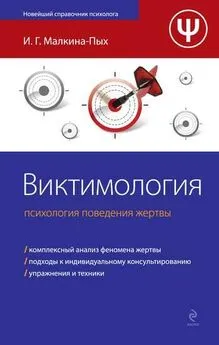Ирина Малкина-Пых - Терапия пищевого поведения
- Название:Терапия пищевого поведения
- Автор:
- Жанр:
- Издательство:неизвестно
- Год:неизвестен
- ISBN:нет данных
- Рейтинг:
- Избранное:Добавить в избранное
-
Отзывы:
-
Ваша оценка:
Ирина Малкина-Пых - Терапия пищевого поведения краткое содержание
Избыточный вес остается актуальной проблемой, несмотря на то, что чуть ли не каждый месяц появляется новое средство или метод, позволяющие гарантированно похудеть. Огромная индустрия производства всевозможных таблеток, поясов для похудения и других чудодейственных способов сбросить вес процветает, а масса тела среднестатистического россиянина год от года увеличивается.
Одна из причин сложившейся ситуации состоит в том, что большинство способов нормализации веса устраняют следствие, а не причину. Между тем психология и психотерапия располагают вполне реальными и весьма многочисленными подходами и методами, способными помочь человеку избавиться от переедания и лишнего веса. Именно психотерапия дает наиболее надежные результаты в преображении собственной внешности. И в развитых странах, где еще в прошлом столетии отошли от многих способов лечения, до сих пор практикуемых в России, для снижения веса обычно обращаются к психотерапевтам. Именно психотерапия нормализует пищевое поведение и помогает отказаться от старых привычек.
В справочнике в достаточном объеме представлены теоретические вопросы психологии пищевой зависимости, но в первую очередь это сборник техник психотерапии, точнее сказать, упражнений, которые психолог (психотерапевт, консультант) может использовать в своей практической работе. Эта книга – руководство для психологов и консультантов, работающих в различных учреждениях (государственных и частных клиниках, больницах и общественных центрах здоровья) с пациентами, страдающими нарушениями пищевого поведения и алиментарным (связанным с перееданием) ожирением.
Терапия пищевого поведения - читать онлайн бесплатно ознакомительный отрывок
Интервал:
Закладка:
Meyer C., Leung N., Feary R., Mann B. Core beliefs and bulimic symptomatology in noneating-disordered women: The mediating role of borderline characteristics // Int. J. Eat. Disord., 2001, vol. 30 (4), pp. 434–440.
Milkman H., Sunderwirth S. Craving for Ecstasy. Lexington Books, Lexington, Massachusetts. – 1987.
Miller C.T. Social interactions of obese and non-obese women // J. Pers., 1990, vol. 58(2), pp. 365–380.
Miller P.M., Watkins J.A., Sargent R.G., Rickert E. J. Self-efficacy in overweight individuals with binge eating disorder // Obes. Res., 1999, vol. 7(6), pp. 552–555.
Miller S. M. Cognitive informational styles in the process of coping with threat and frustration // Advances in Behaviour Research and Therapy, 1989, N 11, pp. 223–234.
Milligan R.-J., Waller G. Anger and bulimic psychopathology among nonclinical women // Int. J. Eat. Disord., 2000, vol.28(4), pp. 446–450.
Mills J.K., Andrianopoulos G.D. The relationship between childhood onset obesity and psychopathology in adults // J. Psychol., 1993, vol. 127(5), pp. 547–551.
Mintz L. B., Wright D. Women and their bodies: Eating disorders and addictions. In E. Cook (Ed.), Women, relationships, and power: Implications for counseling. – Alexandria, VA: American Counseling Association, 1993.
Mintz L.B., Betz N.E. Prevalence and correlates ofeating disordered behaviors among undergraduate women // Journal of Counseling Psychology, 1998, vol. 35, pp. 463–471.
Minuchin P. The middle years of childhood. Monterey, CA: Brooks Cole, 1977.
Minuchin P.P., Shapiro E. K. The School as a Context for Social Development. In E.M. Hetherington, (Ed.), P.H. Mussen, (series ed.), Handbook of Child Psychology: Vol. 4. Socialization, Personality and Social Development, New York: Wiley, 1983.
Mitchell J. Subtyping of bulimia nervosa // Int. J. Eat. Dis., 1992, vol. 11(4), pp. 327–337.
Mitchell J.E., Pyle R.L., Eckert E.D., Hatsukmi D., Pomery C., Zimmerman R. A comparison study of antidepressants and structured intensive group psychotherapy in the treatment of bulimia nervosa // Arch. Gen. Psychiatry, 1990, vol. 47, pp. 149–157.
Mitscherlich A. Krankheit als Konflikt, Bd. 1–2. Suhrkamp, Frankfurt am Main, 1956.
Mizes J. S. Assertion deficits in bulimia nervosa: Assessment via behavioral, self-report and cognitive measures // Behav. Ther., 1989, vol. 20(4), pp. 603–608.
Mizes J.S. Bulimia nervosa. In Bellack, A.S., Hersen, M. (Eds.), Handbook of behavior therapy in the psychiatric setting. New York: Plenum, 1995.
Monello L. F., Mayer J. Obese adolescent girls – an unrecognized minority // Am. J. Clin. Nutrit., 1963, vol. 13, pp. 35–39.
Morgan D. (Ed.) Eating disorders, body image and the media. – London: British Medical Association, Board of Science and Education and the BMA Science Department, 2000.
Musante G. J., Costanzo P. R., Friedman K. E. The comorbidity of depression and eating dysregulation processes in a diet-seeking obese population: A matter of gender specificity // Int. J. Eat. Disord., 1998, vol. 23(1), pp. 65–75.
Musicant S. Authentic Movement and Dance Therapy // American Journal of Dance Therapy, 1994, vol. 16(2), pp. 91-106.
Mussel M.P., Mitchell J.E., Weller C.L., Raymond N.C., Crow S.J., Crosby R. Onset of binge eating, dieting, obesity and mood disorders among subjects seeking treatment for binge eating disorder // Int. J. Eat. Disord., 1995, vol. 17, pp. 395–401.
Nagel K.L., Jones K.H. Sociocultural factors in the development of eating disorders // Adolescence, 1992, vol. 27, pp. 107–113.
Nangle D.W., Johnson W.G., Carr-Nangle R.D., Engler L.B. Binge eating disorder and the proposed DSM-IV criteria: psychometric analysis of the Questionnaire of Eating and Weight Patterns // Int. J. Eat. Disord., 1993, vol.16(2), pp. 147–157.
Neal A. National trauma and collective memory. Major events in the American century. N. Y., 1998.
Nir Z., Neumann L. Self-esteem, internal-external locus of control, and their relationship to weight reduction // J. of Clin. Psychol., 1991, vol.47(4), pp. 568–575.
Nitsch J. R. Zur Gegenstandsbestimmung der Stressforschung. In J. R. Nitsch (Hrsg.). Stress. Theorien, Untersuchungen, Massnahmen. Bern: Hans Huber, 1981.
Noll S. M., Fredrickson B. L. A mediational model linking self-objectification, body shame, and disordered eating // Psychology of Women Quarterly, 1998, vol. 22, pp. 623–636.
Nydes J. The paranoid – masochistic character // Psychoanalytic Review, 1963, vol. 50, pp. 215–251.
O’Dea J. A. Body image and nutritional status among adolescents and adults-a review of the literature // Austr. J. Nutr. Diet., 1995, vol.52(2), pp. 56–67.
Ogden J., Thomas D. The role of familial values in understanding the impact of social class on weight concern // Int. J. Eat. Disord., 1999, vol. 25(3), pp. 273–279.
Ogden J., Wardle J. Cognitive restraint and sensitivity to cues for hunger and satiety // Physiol. and Behav., 1990, vol. 47(3), pp. 477–481.
Olmsted M.P., Kaplan A.S., Rockert W. Rate and prediction of relapse in bulimia nervosa // Am. J. Psychiatry, 1994, vol. 151, pp. 738–743.
Oppenheimer R., Howells K. Adverse sexual experience in childhood and clinical eating disorders: A preliminary description // J. Psychiatr. Res., 1985, vol.19(2–3), pp. 357–361.
Oppikofer R. A journey to «my land». Psychomotricity and growth-process. Los Angeles and Geneva, 1976/77.
Pachinger Th. Adipositas. Theoretische Grundlagen sowie Bescheribung und Evaluation eines Behandlungsansatzes unter spezieller Berь cksichtigung psychologischer und physiologischer Parameter. Unv. Diplomarbeit. Salzburg, 1997.
Pallaro P. (Ed). Authentic Movement: Essays by Mary Starks Whitehouse, Janet Adler and Joan Chodorow. – London: Jessica Kingsley Publishers, 2000.
Palmer R. L. Dietary chaos syndrome: a useful new term? British Journal of Medical Psychology, 1979, vol. 52(1–4), pp. 187–190.
Pawlow L.A., O’Neil P.M., Malcolm R. J. Night eating syndrome: effects of brief relaxation training on stress, mood, hunger, and eating patterns // International Journal of Obesity, 2003, vol. 27(8), pp. 970–978.
Paxton S. J., Diggens J. Avoidance coping, binge eating, and depression: An examination of the escape theory of binge eating // Int. J. Eat. Dis., 1997, vol. 22(1), pp. 83–87.
Pearce M.J., Boergers J., Prinstein M. J. Adolescent obesity, overt and relational peer victimization, and romantic relationships // Obes. Res., 2002, vol. 10(5), pp. 386–393.
Pearson J., Goldklang D., Striegel-Moore R. Prevention of eating disorders: challenges and opportunities // Int. J. Eat. Disord., 2002, № 3, pp. 233–239.
Pelchat M. L. Food, craving, obsession, compulsion and addiction// Psychol. Behav., 2002, vol. 76(3), pp. 347–352.
Pelchat M.L. Food cravings in young and elderly adults // Appetite, 1997, vol. 28, pp. 103–113.
Pendleton L., Moll S. H., Tisdale M.J., Marler M. R. The 4, 5, 6 configuration on the MMPI in bulimics VS, controls // J. Chin. Psychol., 1990, vol. 46(6), pp. 811–816.
Perrez M., Reicherts M. Stress, Coping, and Health. A Situation-Behavior Approach, Theory, Methods, Applications. Seattle-Toronto-Bern-Gottingen: Hogrefe Huber Publishers, 1992.
Peterson C.B., Mitchell J. E. Psychosocial and pharmacological treatment of eating disorders: A review of research findings // J. Clin. Psychol., 1999, vol. 55, pp. 685–697.
Petzold E., Reindell A. Klinische Psychosomatik. Quelle Meyer, Heidelberg (UTB 991), 1980.
Pinhas L., Toner B.B., Ali A., Garfinkel P. E., Stuckless N. The effects of the ideal of female beauty on mood and body satisfaction // Int. J. Eat. Disord., 1999, vol.25(2), pp. 223–226.
Pi-Sunyer F. X. Effects of the composition of the diet on energy intake // Nutr. Rev., 1990, vol. 48, pp. 94-105.
Pliner P., Chaiken S. Eating, social motivations, and self-presentation in women and men // Journal of Experimental Social Psychology, 1990, vol. 26, pp. 240–254.
Plutchik R. A general psychoevolutionary theory of emotion. In R. Plutchik, H. Kellerman (Eds.). Emotion: Theory, research, and experience. Vol. 1: Theories of emotion. New York: Academic Press, 1979.
Polivy J., Herman C. P. Dieting and bingeing // American Psychologist, 1985, vol. 40, pp. 193–201.
Polivy J., Herman C. P. Dieting and its relation to eating disorders. In K. D. Brownell, C. G. Fairburn (Eds.), Eating Disorders and Obesity: A Comprehensive Handbook. New York: Guilford Press, 1995.
Polivy J., Herman C. P. Distress and eating: Why do dieters overeat? // Int. J. Eat. Disord., 1999, vol. 26(2), pp. 153–164.
Polivy J., Herman C.P. Etiology of binge eating: Psychological mechanisms. In C. F. Fairburn G. T. Wilson (Eds.), Binge Eating: Nature, Assessment, and Treatment. New York: Guilford Press, 1993.
Polivy J., Herman C.P., Warsh S. Internal and external components of emotionality in restrained and unrestrained eaters // J. Abnorm. Psychol., 1978, vol. 87, pp. 497–504.
Porzelius L.K., Houston C., Smith M., Arfken C., Fisher E. Comparison of a standard behavioral weight loss treatment and a binge eating weight loss treatment // Behav. Ther., 1995, vol. 26, pp. 119–134.
Probst M. Body experience in eating disorder patients. – Kortenberg: University Center Sint Jozef, 1997.
Prochaska J.O., DiClemente C.C., Norcross J. C. In search of how people change: Applications to addictive behaviors // American Psychologist, 1992, vol. 47, pp. 1102–1114.
Prochaska J.O., DiClemente C.C. Standartized, individualized, interactive, and personalized self-help programs for smoking cessation // Health Psychol., 1993, vol. 12, pp. 399–405.
Proctor L., Morley S. (1986). Demand characteristics in body size estimation in anorexia nervosa // British Journal of Psychiatry, 1986, vol. 149, pp. 113–118.
Prultt J.A., Kappius R.E., Gorman P.W. Bulimia and fear of intimacy // J. Clin. Psychol., 1992, vol. 48(4), pp. 472–476.
Pudel V. Ernдhrungspsychologie. – Gцttingen: Hogrefe, 1991.
Pudel V. Fragebogen zum Bverhalten. – Gцttingen: Hogrefe, 1988.
Pudel V. Verhaltenpsychologische Aspekte der Adipositas. Referat auf dem Symposium: Diatische, psychologische und soziale Aspekte des Ubergewichts. – Zьrich, 1976.
Pudel V., Maus N. Ernдhrung. – Gцttingen: Hogrefe, 1990.
Puhl R., Brownell K. D. Bias, Discrimination, and Obesity // Obes. Res., 2001, vol.9(12), pp.788–805.
Rabe-Jablonska J., Sobow T. The links between body dysmorphic disorder and eating disorders // Eur. Psychiatry, 2000, № 5, pp. 302–305.
Rabin M. Art therapy and eating disorders: The self as significant form. – New York: Columbia University, 2003.
Rand M., Fewster G. Self, Body and Boundaries. Body Mind Psychotherapy. – http://www.drrandbodymindtherapy.com/ articles.html, 1995.
Raphael F.J., Lacey J. Hubert. Sociocultural aspects of eating disoders // Ann. Med., 1992, vol. 24(4), pp. 293–296.
Ravussin E., Lillioja S., Knowler W.C., Christin L., Freymond D., Abbott W.G., Boyce V., Howard B.V., Bogardus C. Reduced rate of energy expenditure as a risk factor for body-weight gain // N. Engl. J. Med., 1988, vol. 318(8), pp. 467–472.
Reid M., Burr J. Are eating disorders feminine addictions?// Addiction Research, 2000, vol. 8(3), pp. 203–211.
Ricca V., Mannucci E., Mezzani B., Di Bernardo M., Barciulli E., Moretti S., Cabras P.L., Rotella C. M. Cognitive-behavioral therapy versus combined treatment with group psychoeducation and fluoxetine in bulimic outpatients // Eat Weight Disord., 1997, vol. 2, pp. 94–99.
Ricca V., Mannucci E., Zucchi T, Rotella C.M., Faravelli C. Cognitive-Behavioural Therapy for Bulimia nervosa and Binge Eating Disorder // Psychotherapy and Psychosomatics, 2000, vpl. 69(6), pp. 287–295.
Читать дальшеИнтервал:
Закладка:










